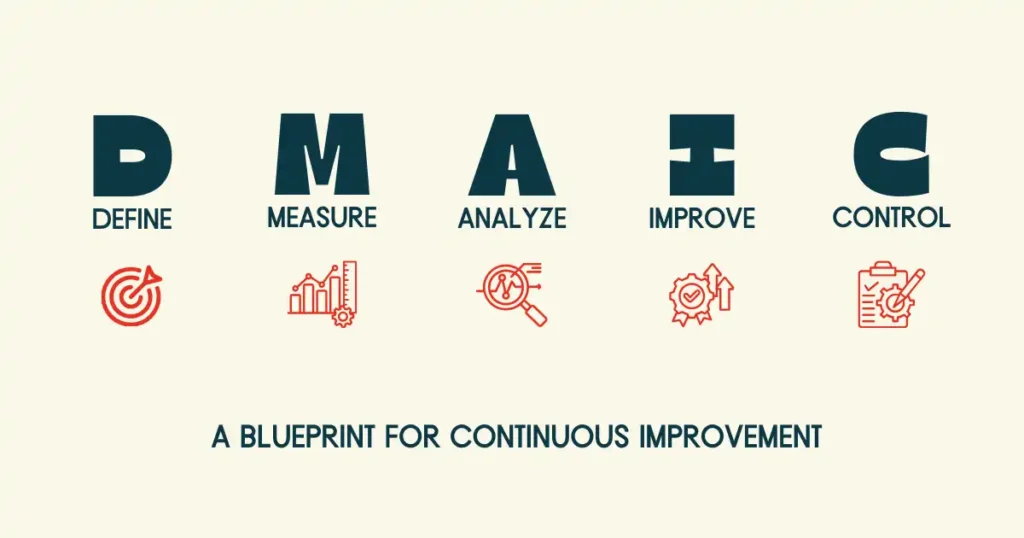Table of Contents
DMAIC – The Game-Changer for Business Excellence
In today’s competitive business landscape, DMAIC (Define, Measure, Analyze, Improve, Control) emerges as a transformative methodology pivotal to the philosophy of Lean Six Sigma. Celebrated for revolutionizing processes at industry giants like Toyota, GE, and Motorola, DMAIC serves as a powerful tool for addressing inefficiencies, enhancing quality, and reducing costs. This structured, data-driven approach enables organizations to solve problems effectively and foster continuous improvement, making it indispensable for achieving business excellence. By leveraging DMAIC, companies can navigate complex challenges and unlock new levels of operational efficiency.
The Roots of DMAIC: A Method Shaped by Decades of Innovation
DMAIC‘s lineage traces back to the 1930s with Walter Shewhart’s development of the PDSA (Plan-Do-Study-Act) cycle, which laid the groundwork for systematic process improvement. This foundational concept was further refined through the Six Sigma approach, spearheaded by Motorola in the 1980s and later adopted by General Electric. DMAIC became integral to Six Sigma, offering a structured framework for enhancing process performance by emphasizing metrics and statistical analysis.
While initially rooted in manufacturing, DMAIC’s versatility has expanded its application to diverse sectors, including healthcare, information technology, and service industries. This adaptability makes it a cornerstone of modern business operations, particularly in the era of digital transformation, where continuous improvement is not just beneficial but necessary. Organizations across various fields now harness DMAIC to streamline processes, enhance service delivery, and achieve strategic goals.
Understanding the Five Phases of DMAIC
Define
The Define phase is foundational, setting the stage for the entire DMAIC process. Here, it’s crucial to clearly articulate the problem, define the project scope, establish goals, and understand stakeholder needs. Tools such as the Project Charter, Voice of the Customer (VoC), and Value Stream Mapping are instrumental in this phase. For example, a manufacturing company seeking to reduce production defects might begin by defining customer pain points and expectations. By doing so, they can align their improvement efforts with customer demands, ensuring that the solutions developed are both relevant and impactful.
Measure
In the Measure phase, the focus shifts to quantifying the current process performance to establish a baseline. This involves collecting data to understand the process’s existing state and identify areas for improvement. Tools like Process Mapping, Capability Analysis, and Pareto Charts are commonly used. Consider a healthcare clinic that measures patient wait times to pinpoint inefficiencies. By understanding the current performance metrics, the clinic can identify specific areas for improvement, paving the way for effective interventions.
Analyze
The Analyze phase is about uncovering the root causes of problems through rigorous data analysis. This involves identifying patterns, correlations, and potential sources of inefficiency. Tools such as Root Cause Analysis (RCA), Failure Mode and Effects Analysis (FMEA), and Multi-Vari Charts are utilized in this phase. For instance, a financial institution might use RCA to discover that transaction delays stem from outdated software and manual approvals. Identifying these root causes is essential for developing targeted solutions that address the underlying issues.
Improve
During the Improve phase, solutions are implemented to eliminate the root causes identified in the Analyze phase. This involves designing and testing interventions that enhance process performance. Tools like Design of Experiments (DOE), Kaizen Events, and Pilot Testing are employed to refine processes and verify their effectiveness. A retail company, for example, might refine its checkout process to reduce bottlenecks through small, incremental Kaizen improvements. By iteratively testing and refining solutions, organizations can achieve significant performance enhancements.
Control
The Control phase is crucial for maintaining the gains achieved through the previous phases. It involves continuous monitoring to ensure that improvements are sustained over time. Tools such as Control Plans, Statistical Process Control (SPC), and 5S are vital in this phase. For example, a logistics firm that has streamlined its shipping process might implement SPC charts to track performance and ensure that the process remains efficient. By maintaining control over the improved process, organizations can prevent regression and continue to benefit from the enhancements made.
DMAIC vs. DMADV: When to Redesign and When to Improve
While DMAIC is focused on incremental improvements to existing processes, DMADV (Define, Measure, Analyze, Design, Verify) is geared towards creating new processes or products. The choice between DMAIC and DMADV depends on whether the goal is to enhance an existing process or design something entirely new.
For instance, DMAIC is ideal for improving customer service response times by identifying and reducing inefficiencies within the current system. On the other hand, DMADV might be appropriate for redesigning a product development process to meet new market demands, ensuring that the final product aligns with customer expectations and quality standards.
Organizations must carefully assess their objectives and the nature of the problem at hand to determine the right approach. If the issue lies within process inefficiencies, DMAIC provides a robust framework for improvement. However, if a complete redesign is necessary to meet new requirements or standards, DMADV offers a structured methodology for creating effective solutions from scratch.
Real-World Success Stories Powered by DMAIC
The transformative power of DMAIC is exemplified through the success stories of renowned companies that have harnessed this methodology to achieve substantial improvements.
Toyota has long been a pioneer in process improvement, utilizing DMAIC to revolutionize production. By applying the Define phase, Toyota identified waste as a critical issue within its manufacturing processes. Using the Measure and Analyze phases, they collected data to understand inefficiencies and pinpointed root causes. Through the Improve phase, Toyota implemented lean manufacturing principles, significantly reducing waste and enhancing product quality. The Control phase ensured these advancements were sustained, solidifying Toyota’s reputation for quality and efficiency.
Nike leveraged DMAIC to bolster supplier performance and minimize product defects. In the Define phase, Nike recognized supplier inconsistencies as a major challenge. The Measure phase involved gathering data on defect rates and supplier performance metrics. By analyzing this data, Nike identified key areas for improvement. Implementing the Improve phase, they collaborated with suppliers to refine processes, leading to a notable decrease in defects. Finally, the Control phase established ongoing monitoring systems to maintain these improvements, resulting in enhanced product quality and supplier relationships.
At the Mayo Clinic, DMAIC was pivotal in streamlining patient care processes. During the Define phase, the clinic focused on reducing patient wait times, a major pain point. The Measure phase involved tracking patient flow and wait times across various departments. Using the Analyze phase, they identified bottlenecks in the system. The Improve phase saw the implementation of scheduling changes and process optimizations, which significantly reduced wait times. The Control phase ensured these improvements were sustained, leading to increased patient satisfaction and improved care quality.
Each of these examples illustrates the power of DMAIC in driving measurable improvements, showcasing its application across diverse industries and challenges.
The Benefits and Challenges of Implementing DMAIC
Implementing DMAIC offers numerous benefits but also presents certain challenges. Understanding both can help organizations effectively leverage this methodology.
Benefits of DMAIC include:
- Data-driven decision-making: DMAIC relies on empirical data to guide improvements, ensuring that decisions are objective and informed.
- Cost reduction through efficiency improvements: By identifying and eliminating inefficiencies, organizations can significantly reduce operational costs.
- Enhanced customer satisfaction: Continuous process refinement leads to better quality products and services, improving customer satisfaction and loyalty.
However, organizations may face challenges such as:
- Resistance to change within teams: Employees may be hesitant to adopt new processes. Overcoming this requires clear communication of the benefits and involving teams in the change process.
- Gathering accurate data during the Measure phase: Ensuring data accuracy is crucial. This can be addressed by training staff in data collection techniques and employing robust data management systems.
- Maintaining improvements in the Control phase: Sustaining improvements requires ongoing monitoring and adjustments. Establishing a culture of continuous improvement and using tools like SPC can help maintain gains.
To overcome these challenges, involve cross-functional teams to foster collaboration and communication. Clearly articulate the benefits of DMAIC to stakeholders to build support and commitment.
DMAIC in the Age of Digital Transformation
In the digital age, DMAIC is evolving with new technologies enhancing its application.
Automation and artificial intelligence (AI) are revolutionizing the Measure and Analyze phases by enabling real-time data collection and analysis. For example, AI can quickly identify patterns and inefficiencies, allowing for faster and more accurate decision-making.
Businesses can integrate advanced analytics into the Measure and Analyze phases to detect inefficiencies swiftly. A case study of a software company illustrates this: by using DMAIC and data analytics, they improved customer onboarding and reduced churn rates. In the Define phase, the company identified onboarding as a critical issue. The Measure and Analyze phases utilized advanced analytics to track user engagement and identify areas for improvement. Through the Improve phase, they optimized the onboarding process, leading to higher customer retention. Continuous monitoring in the Control phase ensured these improvements were maintained.
Organizations are encouraged to explore digital tools to enhance their DMAIC process, unlocking new opportunities for efficiency and growth in a rapidly changing business environment.
DMAIC – Your Key to Sustainable Growth
DMAIC is a cornerstone for fostering a culture of continuous improvement and achieving sustainable growth. Its structured approach empowers organizations to tackle complex business problems with precision and efficacy, driving significant enhancements across various domains.
By embracing DMAIC, companies can transform challenges into opportunities for innovation, efficiency, and excellence. As demonstrated by real-life success stories, DMAIC not only improves processes but also enhances customer satisfaction and reduces costs.
Now is the time for organizations to begin their DMAIC journey. By applying this methodology to their processes, they can achieve remarkable improvements and create a lasting impact. Let these real-world examples inspire you to unleash the full potential of DMAIC in your own business endeavors.











